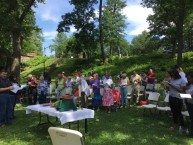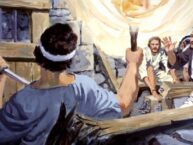![]() April 30, 2017: May God’s words alone be spoken, may God’s words alone be heard. Amen.
April 30, 2017: May God’s words alone be spoken, may God’s words alone be heard. Amen.
This parish, as joy filled and loving as any I have ever experienced, is walking through a time of grief and despair for several of our sisters and brothers here, and I cannot imagine a more fitting time for us to be in Eastertide. Not because those who are in pain will suddenly be filled with resurrection joy. No, not at all. Remember, we didn’t just drop into Easter – we moved first through the darkness of Lent, and stood despairing in the shadow of the cross on Good Friday. But for some, Good Friday is something that isn’t just a day on the liturgical calendar, but a very real experience, one in which they will remain for some time – and that is okay. It is okay because those who love them stand in the light of Easter’s resurrection as a symbol of hope and promise, ready to help them, when, or if, their sisters and brothers are able to lift their grief filled eyes to see.
Perhaps that is why this story about the two disciples walking along in grief at the death of their teacher is so powerful for us, because it is also familiar. There are not too many people in this world who have not experienced grief, despair, hopelessness, or a feeling of being lost, alone, and afraid. The story of these two is a human story, our story.
Now, the interesting thing about this gospel narrative is what we have imagined about it. How many of you just assume that these are two men walking on this road? That, my friends, is a reflection of our society, not the scriptures. The text says that two disciples were walking from Jerusalem along the road on the way to a village called Emmaus. Nowhere does it say these were two men! I checked the Greek, and even there it is gender neutral. Given that the bible is rife with examples of women going unnamed, and given that the bible authors have no problem usually telling you the names of every man in the story, I posted a question out to my scholarly friends – was this a woman? Dr. Joanna Dewey, who was once the Dean at Episcopal Divinity School, is a member of the scholarly group called “The Jesus Seminar,” and lectures all around the country as one of the foremost Markan scholars, happens to not only be my former Greek professor, but is a dear friend of mine too. Her answer to my question “was this a woman?”– “So argues John Dominic Crossan, as well as me.” John Dominic Crossan you all have likely seen on History Channel specials whenever someone is trying to do a documentary on the historical Jesus.
So, there you have it from two distinguished biblical scholars – Cleopas and his wife, girlfriend, or female best bud, were walking along the road to Emmaus. I say this a lot, but see – bible study can be so much fun! Don’t you all just want to study Greek now? Now, at Christ Church, we put on the front of every bulletin a full color picture that is tied to one of the lectionary readings, in this case – the gospel, so that you might take it home and use it for visio divina – divine seeing – a way of meditating on the scriptures. Did you notice anything? Take a really good look. Pretty awesome, right? Whose there walking and dining with Jesus? A man and a woman!
So, let’s see what happens. I’ll do a revised telling of the story, you know, as I do. So, Cleopas and….oh let’s call her Theodora – Greek for “gift of God” – Cleopas and Theodora encounter the risen Jesus, but their eyes were prevented from recognizing him (that is a whole other sermon right there).
Jesus says “What’s up?” I can just see Cleopas – “What’s up? What rock have you been hiding under? Are you the only one who didn’t hear or see what happened in the city? I mean, the chief priests handed over to the Romans our teacher, the greatest of prophets, and Pilate had him crucified. Where the heck have you been – it was in all the papers. Not only that, but our friend Mary told us that the tomb they laid him in was empty – and that she saw Jesus (that was his name btw, since you seem to be clueless) – she said that Jesus, the one that they crucified, was alive! Some of the guys went to check it out, but they came back mumbling something about “alternative facts,” because while the tomb was empty – they didn’t see him. At any rate, we had hoped he was the One – the One we had all been praying for to redeem Israel. We don’t know what to make of any of it, our hearts are broken, so we left town.”
Now, their first clue that something was not what it seemed should have been that Jesus didn’t say to that crazy news “What have you two been drinking?” or “Fake news!” Instead, Jesus does a face palm and says “Apparently the ones hanging out under a rock are you two – don’t you know this new news is actually old news? This is what was supposed to happen according to scripture.” And he then began to teach them.
And here is the best part…Just as they seemed about to part ways as they neared the village near nightfall, Theodora and Cleopas invited Jesus to stay with them. They were living what they believed, fulfilling the law to welcome the stranger, and to offer hospitality, something I wish we all did more of today, but in those days, where it could mean life or death to the traveler, it was crucial. During supper, Jesus plays host to them – rather than they to him – breaking the bread. And when he did this, they recognized him, and then he was gone.
If the story ended there, it would still be one of the best gospel narratives of the resurrection, but it doesn’t. It begins on the road to Emmaus, but it is the road to Jerusalem that completes the journey! They get up and return to tell the others what happened – only to find out that Jesus apparently left that room in the village with Cleopas and Theodora to enter the room of the disciples. Later in the week, Jesus returns for Thomas, as we heard last week, and then on another day, cooks up a mean BBQ for some of them on the shores of the Sea of Tiberias – gotta love a savior who cooks!
Jesus seems to be popping up all over the place – and the thing we often miss about these experiences is WHO he decides to do the “Look who’s back!” trip on. Think about it… on the morning of the first day after he is buried, he meets up with Mary Magdalene – a woman disciple. Not Peter, James, John, or even the so called “Beloved Disciple – the one who Jesus loves.” Nope – Not even the Fab Four get that first resurrection experience. In fact, when they come around looking for him, Jesus isn’t there, but is instead visiting our friends Cleo and Theo on the road to Emmaus – yup – that happened before the others saw him. Then the disciples, including the gospel version of John, Paul, George, and Ringo finally get their chance.
And, just to be clear, as I said about Thomas before, he didn’t do anything worse than what the others did. When Jesus appeared to them, it wasn’t like they said right away “Oh my gosh – Mary was right, it’s Jesus! Come on in Lord, you must be starving.” No, Jesus had to show them his hands and feet too. But Jesus didn’t leave poor Thomas out of the cold, he returned a week later for him – that’s right – special just for Thomas (and here the church has denigrated him, and Mary for that matter, for centuries). Doubting Thomas, we say – don’t be a doubting Thomas. And in case anyone out there STILL believes this – Mary Magdalene was neve a prostitute. Despite what I heard in a sermon the other day – Mary was NOT a fallen woman. Honestly, folks, including some clergy, need to do more bible study. Mary was labeled that by Pope Gregory, the not-always-so-great, but even the Roman Catholic church has atoned for this injustice – so let’s not ever continue it ourselves.
So, Jesus meets up with Mary, Cleopas & Theodora, and the rest of the disciples on that first day of the resurrection – quite a busy schedule, right? Then we don’t hear about any other appearances until a week later when he comes back for Thomas. But, all this brings up a question…where else was Jesus during the week between his initial appearances to the disciples, and when he returns to meet up with Thomas? If it were me, I would be hanging out by the sea soaking in some rays, and he may have done a bit of that – he had been through a lot, after all. I would have loved it if he had shown up in front of the Sanhedrin or Pilate and said “I’m baaaaaccccckkkk!”
But my guess – being Jesus – he was out encountering others like our friends Cleopas and Theodora – the ones in despair, the ones in pain, the ones who are saying “but, we had hoped” and no longer hope. Why? Because that is where Jesus always goes – to the lost, the lonely, the least, and the last.
I know of a widow who went to church on Maundy Thursday. It had been nearly a year since her husband had passed, and yet, while able to go to work and do the things she needed to do, her heart was still broken, her hope gone. She came to church that Holy Week – mostly out of habit – empty of joy (at least on the inside – she did what she could to not let it show). And on Maundy Thursday, she settled into a pew – not her normal pew (she was, after all, an Episcopalian – she had “her” pew). No, she took one near the back, wanting to just fade into the woodwork and not be noticed.
After hearing of the pain of Jesus in the garden that night, she was suddenly overwhelmed with emotion. She recalled later “I thought I had already cried as much as I could possibly cry, but there I was weeping uncontrollably.” She was grateful to be in one of the back pews, and that there were not too many in church. She threw her raincoat over her head, and laid down along the pew – wanting to lock herself into her own tomb of pain. There she stayed for a very long while – long after most had left the church. And then…it seemed, something overcame her – had changed for her. “I don’t know what it was,” she later said, “but there was a moment when, exhausted and having no tears or fight left, I just was laying there on the pew, in the dark, under my coat. And then I sensed something…or someone…I don’t know, but I knew in that moment I was not alone… and in my heart was kindled a tiny spark of hope…just a spark, but it was enough. Maybe a spark is always enough in an empty heart. I would not reach Easter for a long time, but somehow I knew that I would. I really would – in time.”
“Maybe a spark is always enough in an empty heart.”
“Easter is not for full people. Easter is for empty people.”[1] It is for people who have experienced Holy Week and are in need of the Good News. The reason these resurrection stories are so powerful, especially this one of the two disciples walking without hope on the road to Emmaus, is that it is our story.
The funny thing about Emmaus is – nobody has any idea where it is. It isn’t on any map, and even ancient texts give various accounts of where it might be. There have been no archeological findings to give us a clue. All we know is that there is a road between it and Jerusalem – between it and the cross. Maybe we have all been on the road to Emmaus. Maybe that road is the one we travel when we are adrift, need to get away from the pain, trying to find our way. Maybe it is the place we need to be at times, when what we hoped for has been lost to us, when we are covered in a raincoat drowning in sorrow. Maybe it is the road we walk between Maundy Thursday and Easter. And it is the road on which we are joined by God.
The road to Emmaus is a place where we find Jesus…or really, Jesus finds us. Jesus, the God who meets us in our pain, who guides us from despair, who is willing to walk with us for as long as we allow – for as long as we invite him to, until we are able to take the road back to Jerusalem. It is the path that reminds us that our God is one that walks alongside us in our most vulnerable moments – when we are scared, when our hearts are broken, when the pain of loss is overwhelming, when we once “had hoped,” and now have none.
And the church – our very worship – is an Emmaus journey every week too. Here, no matter what may be happening in our lives – joyous or despairing – we gather around the interpretation of the scriptures, we share the meal which reveals Christ presence, and then we are impelled to leave this place and go tell others about what we experienced here. Like the story in the gospel of John about Thomas – Luke’s answer for those who say “I want to see the risen Jesus myself” is – go to church.
And at church, we are in Eastertide, and the truth of Easter, is that the resurrection doesn’t erase what has happened, it just recasts it. Jesus still dies, but lives again. Maundy Thursday and Good Friday still happen, but that is the only way to Easter. We still will walk toward Emmaus at points in our life, but Jesus will always meet us where we are, walk alongside us, until we are able to experience resurrection – no matter how long that may take.
Christ is alive – and will meet us in our pain, in our spiritual questioning. Everywhere we look, Christ will be – most especially in the stranger, the homeless, the poor, the marginalized, and the lonely.
So, in this Eastertide, let us walk our journey to Emmaus by opening our hearts to the scriptures, opening our eyes to the Christ present with us in the breaking of the bread, and then share the Good News – that Christ is risen – with others, especially those whose hearts are broken, those who live in fear, those who feel unloved, those without hope. Let us meet them on their road to Emmaus, walk with them on their journey (not ours) until they see Jesus.
And they will see him, because if we are living what we believe, if we walk with them, they will see Christ in each of us . And the crazy thing about it is – we will encounter Christ too – in them. And through it all, the road to Emmaus becomes, in time, the road back to Jerusalem, where the cross doesn’t disappear, where what happened isn’t forgotten, but where we are able to live and love beyond it in a new life, because we know that God is alive – that life is stronger than death – and that real love lives forever.
Thanks be to God!
Amen.
For the audio from the 10:30am service, click here:
[1] Homileticsonline.com
Rev. Diana L. Wilcox
Christ Church in Bloomfield & Glen Ridge
April 30, 2017
The Third Sunday of Easter
1st Reading – Acts 2:14a,36-41
Psalm 116:1-3, 10-17
2nd Reading – 1 Peter 1:17-23
Gospel – Luke 24:13-35





